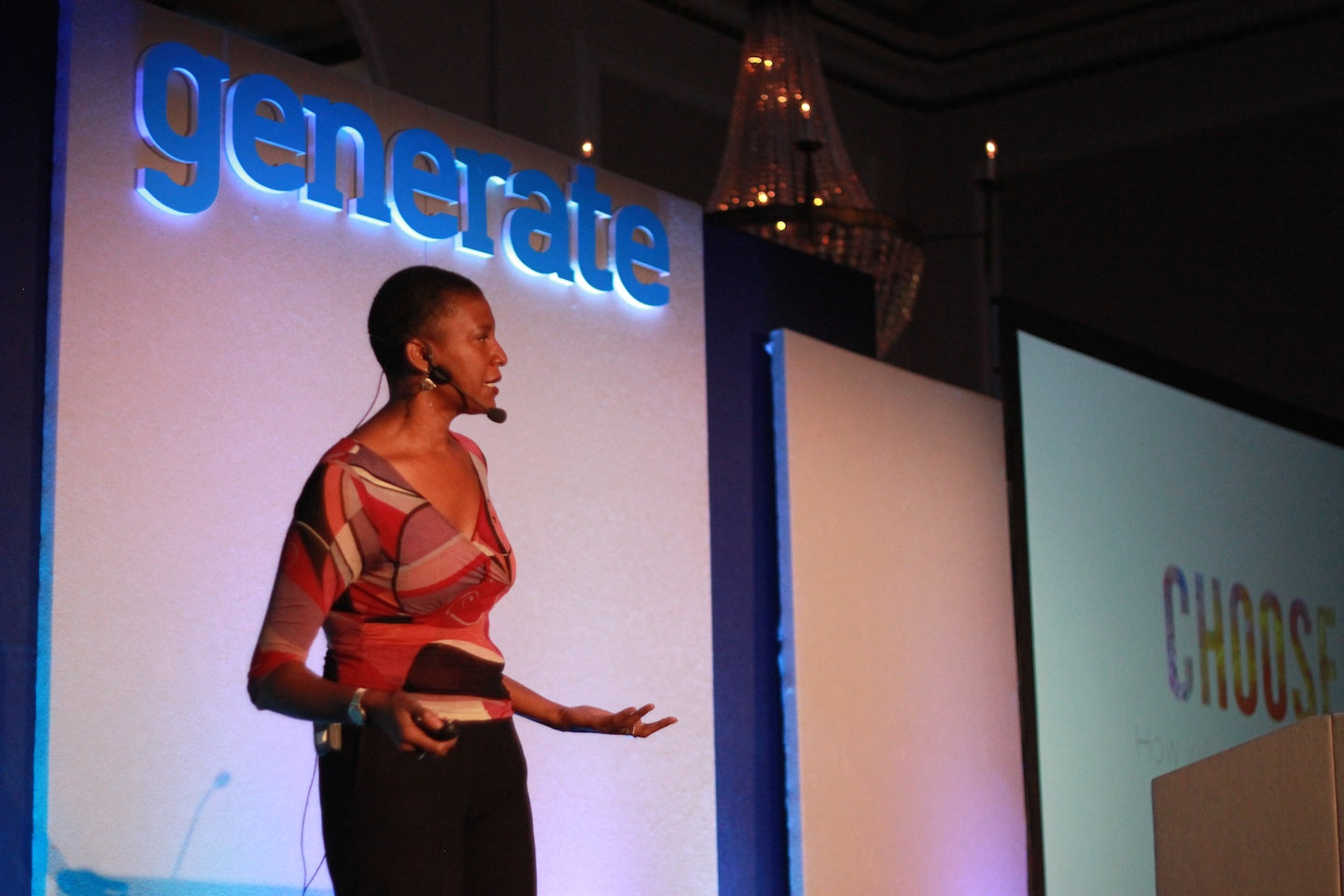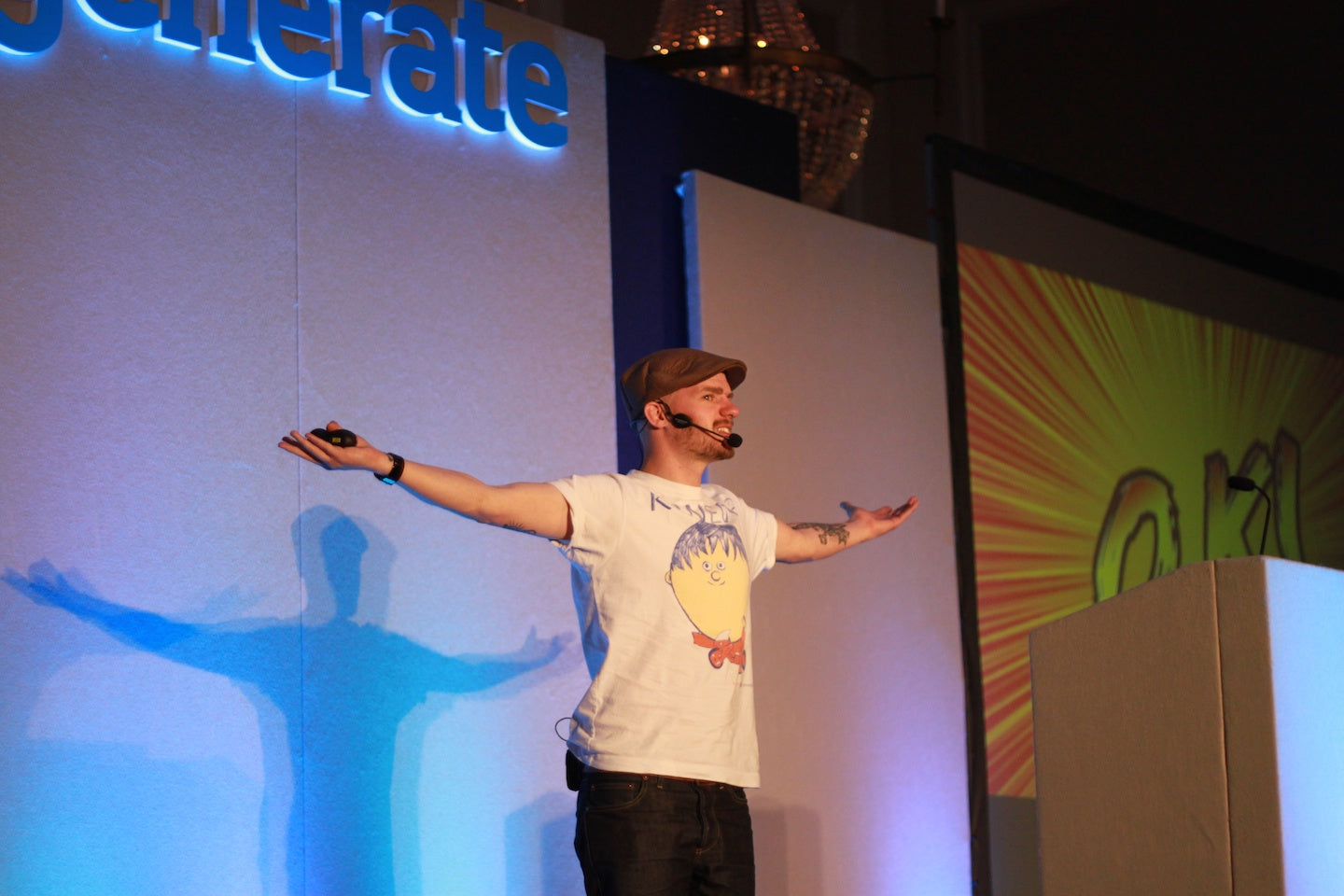Venue: Grand Connaught Rooms, London
Date: Friday, 26 September 2014
As I picked up my lanyard and made my way into the grand reception room for net magazine’s Generate London conference, I noticed the good mix of men and women in attendance – a refreshing change from many other web events.
I didn’t spot too many familiar faces as I made my way through to the coffee bar, so I sought out the friendly smile of my good friend Keir Whitaker on the Shopify stand. By 9 am the room had filled up and it was soon time to take our seats for the first talk.
You might also like: 4 Overlooked Tactics to Find New Clients Offline
Morning Sessions

I’ve seen Denise Jacobs speak a few times and love the way she presents slightly less conventional ideas in a practical way. Ideas that people outside of our industry may consider weird or a little far out, such as letting ideas use us – not vice versa. She recommends we “listen and talk to the idea.” Denise triggered some interesting thoughts and set my mind up nicely for the rest of the day.
Next up was Meagan Fisher, who shared her ideas for “being less terrible at the business of design.” Whilst we might all know it, hearing her say “Be nice on the Internet” and “If a client says they know what the website should look like, you should walk away” was good reinforcement.
After a quick coffee break, I moved upstairs to catch Chris Murphy on the second track. He talked about his experience of building Get Invited, a ticketing app, with his students. He compared bootstrapping with investment and reminded us that 100% of £0 is £0, but 50% of £2m is £1m.

Next I headed downstairs to watch Elliot Jay Stocks on the main stage talk about some of the more advanced features of web type, such as opentype ligatures and subsetting.
It was an updated version of a talk I’d seen him give a year or two previously at Ampersand Conf, and despite being a long-time type nerd, I really wasn’t ready to dive that deep. This time, however, I couldn’t wait to get home and start playing with it all.
Feed the Geeks
We broke for lunch, and boy did we get a lunch! Expecting the obligatory brown paper bagged sandwich and crisps (chips for you North American readers), we were instead presented with an almost regal hot food buffet – something I’d not seen at a web event since @media back in 2007.
Fed, watered and rested it was time for the afternoon sessions.
Afternoon Sessions
Now here’s the problem with two track conferences: two talks I want to see on at the same time.
I was hoping to finally see Anna Debenham talk, but having heard amazing things about Gavin Strange’s session at Reasons To Be Creative, and being a long-term fan of his work, I had already decided I wasn’t going to miss his talk.

I wasn’t disappointed – it was an energy explosion from start to finish. Gav took us through his career, highlighting all the cool things he’s done like the recent Aardman Animations rebranding and the custom Gromit that raised a staggering £30,000 at a charity auction.
He’s a self-confessed “Jack of All Trades.” He likened this to being a polymath, like some famous people through history such as Benjamin Franklin and Leonardo Da Vinci.
I came away with two strong messages: “Just give it a go,” and “If you don’t ask, you don’t get!” Truly inspiring.
Next, a quick move upstairs to catch Johanna Kollmann talking about using UX principles and mental models to design things that make sense before a final coffee break.

It was back to the main room for the closing keynote from Jeremy Keith. I first heard the term ‘progressive enhancement’ ten or so years ago, and I think whilst many of us “get it,” we’re perhaps still not doing it right.
Jeremy reminded us that the web is “responsive” by default and, by using the first-ever website (still online) as an example, that the web is also accessible by default. He argues we should keep websites accessible – not make websites accessible.
The show came to an end with an interesting finish. I was expecting a closing talk by Dribbble co-founder Dan Cederholm, but instead we were presented with an informal fire-side chat from Dan and Meagan Fisher.
The pair talked about Dan’s history, the two of them working together at Dan’s studio Simplebits, and the story of Dribbble.
Party Time!
I’ll confess I have a slight issue with conference after-parties, and I know I’m not alone.
It's not that I'm getting too old for all this, far from it. I’m a seasoned raver and actually DJ quite regularly too. However, after-parties are often held in a dingy basement club with a wannabe superstar DJ force-feeding you the latest club tracks at full volume.
You’re trying to do your best to mingle with your fellow delegates and discuss the highlights of the day, but instead you end up battling with the noise and sink lower into your bottle of free beer.
I soon realized I wasn’t going to be able to continue a conversation inside the club, so broke from the queue and retired to a nearby pub for a chat over a (paid-for) beer with a few fellow attendees. From later tweets, it seemed we made a good move.
To Sum Up
All in all, it was a good day. On reflection, there was perhaps a lack of coherency between talks, but I put that down to the two track format.
I came away inspired, learned a few new tricks, and got to see some of my good friends.
What is at the top of your list of must-attend conferences? Let us know in the comments below.
Read more
- Check Out This Free Ecommerce Training Business Course on Skillshare
- Learn from the Shopify Experts Who Won Build A Business
- Email Deliverability: 5 Ways to Build a Strong Sender Reputation
- 5 Ways to Help Clients Succeed in the Build A Business Competition
- 5 Facebook Messenger Marketing Tactics You Should Use on Your Clients' Stores
- Raise Prices at Your Agency with this Step-by-Step Approach
- Shopify’s Director of Design Talks Tools, Trends, and How to Take Charge
- 4 Conferences You Should Attend
- What is the Gig Economy and How do You Succeed in it

